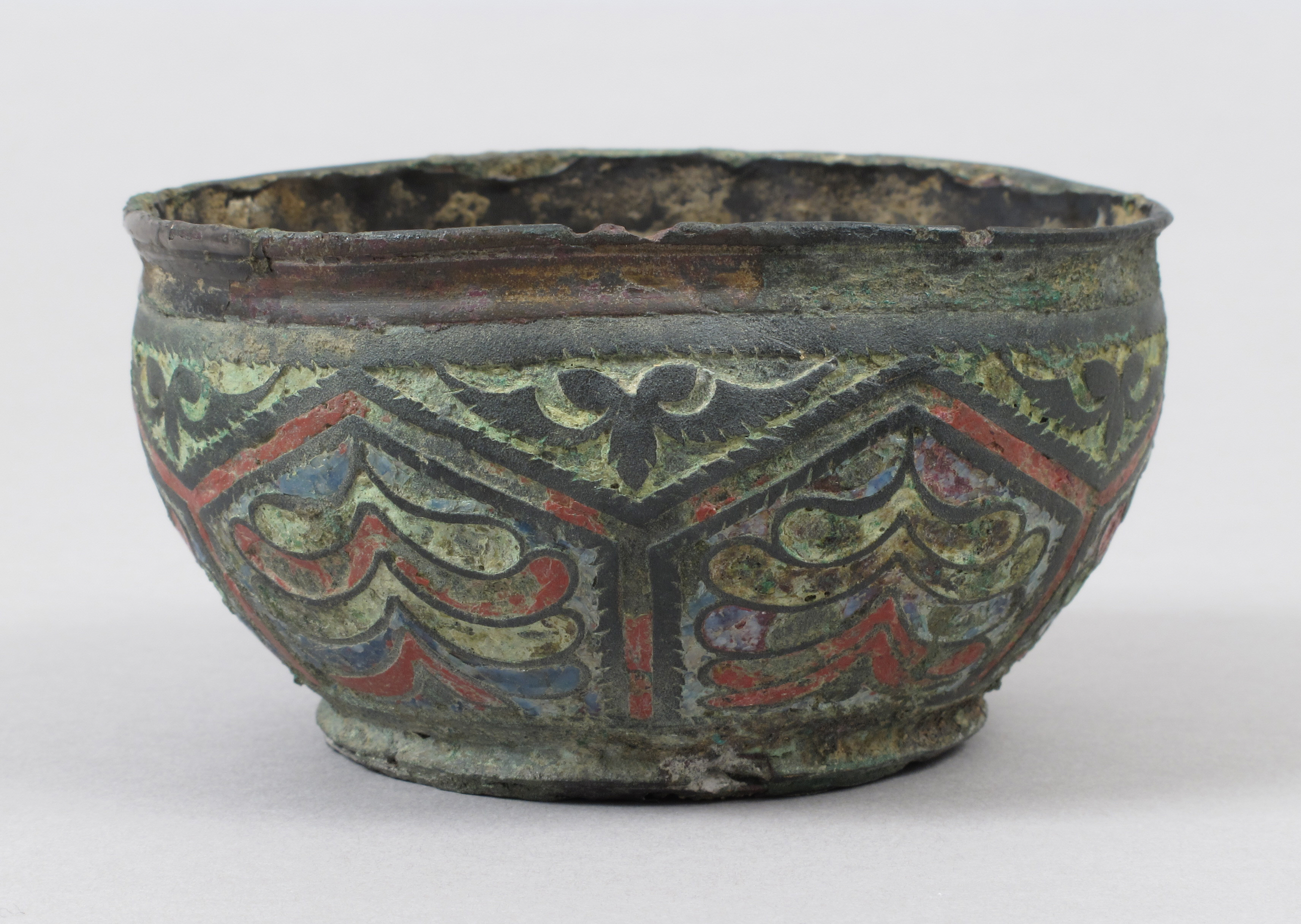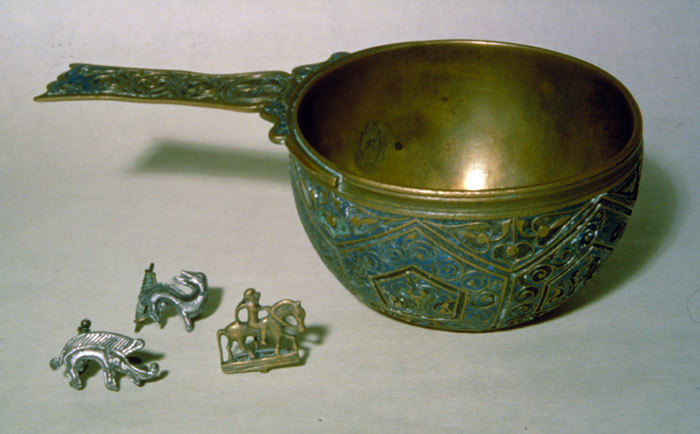Here is the Getty Museum’s page on this artifact. It has several views of the artifact. They mention: “The use of enamel and pentagonal panels is typical of metal vessels made in northern Gaul.” That sounds like there may be more items with similar “pentagonal” (aka dodecahedral) designs to be found on museum websites. Maybe there were matched sets of Gallo Roman dodecahedral bottle stands that went with these pentagonal paneled vessels.
Their provenance entry says a Swiss guy sold it to an American couple in 1991, who then donated it to the museum. It doesn’t sound like they know where or when it was found.
But it’s much easier to enamel on a flat(tish) surface than to do it in the round. And it looks like there are seams between each pentagon - no real reason for that if it’s made in one piece.
Each pentagonal face seems to have a set of concentric circles surrounding a central pentagon. Very similar to the sets of concentric circles surrounding the holes on some dodecahedra.
A bottle stand is the first explanation for dodecahedra that I’ve seen that makes sense. Has anyone ever made that suggestion before? If not, congratulations.
Assuming you’re the first with this idea, you need to communicate this idea with the archaeological community. Find a journal and submit a letter or something.
Yes. In this thread, even. I’m not going to repeat the many arguments against the idea done there.
Yes. But not necessarily dodecahedron shapes. Here’s one from the Met:

Why would you want a single bottle stand with that holds 12 different sized bottles, but only one at a time? Have we found other complicated bottle stands from that time?
I don’t know that the holes would matter for bottles. The holes are likely too small for that. Bottles could sit between the knobs. The different sized holes might be handy for the long skinny vials.
Now that I have seen other Gallo Roman objects with pentagonal, hexagonal, and other geometric designs, it strengthens the notion for me that the dodecahedron design may be more for artistic rather than religious, cultic, or astrological reasons.
Or, whatever motivation there was for the design of the dodecahedra, someone had that same motivation for making a perfume bottle that matched it. Like, if a dodecahedron with circles in the pentagons was a symbol of the sky or something, then maybe someone wanted a perfume bottle that symbolized the sky. Of course, this doesn’t help much, because that would apply equally well no matter what the motivation was, be it religious, astrological, purely geometric, etc.
Well, it helps some, because it suggests that the dodecahedron shape doesn’t have a practical purpose. Whatever practical purpose the hollow perforated dodecahedra might have, it seems highly unlikely that the solid spherical perfume bottle would serve the same purpose.
Those aren’t circles on the bottle, they’re spirals.
If it was lost-wax cast, those apparent seams might be remnants/marks of where pentagonal wax panels were joined to make the wax form - if the joint between the wax pieces is left imperfect, those imperfections would be faithfully reproduced in the bronze.
I think you’re right that enamelling is a bit easier on a piece that can be laid flat(ish), but enamelling non-flat objects appears to have been a solved problem. Precisely making, then soldering together cast bronze panels to make a spherical form that holds liquid, would be a difficult thing.
Look at the details from the Getty museum - the joints go deep and have opened up a bit. If it were just in the wax you’d think they’d have filled them in a bit.
Sure, bowl-shaped and that. But enameling where one part is literally going to be upside-down is much harder. Doable, but a lot harder than joining pre-enameled panels.
I don’t see why. Joining together disparate bronze bits to make a 3-D whole was something the both the Romans and Gauls were very good at - like some of the large bronze Roman statuary, or various La Tène artefacts like helmets. Soldering/brazing is an easy way to do that and leave a watertight join - ask any old-school plumber.
Its the 3D fit of the panels that I think is a bit tricky - compound, curved, mitred joints, but I suppose the process here might have been:
- Make the whole bottle as a wax form.
- Decorate with pentagonal embossed designs
- Cut (the wax bottle) into pentagonal panels
- Cast each panel
- Enamel each panel flat
- Reassemble, filing as necessary, to ensure fit
Is there any reason why enameling must be done all at once? Could they have enameled the top side, then turned it over and done another side?
I suspect that the “seams” are just surface grooves.
If you reheat the piece to melt the new powder, the enamel already added will flow.
OK, that makes sense. Pardon the question; I’m only incidentally familiar with ceramics, and not at all with enamel.
I’m trying to find out if the Romans also did the kind of paste “enamelling” like some earlier La Tène work (where the paste was just heated up and pushed in place, not completely liquified) but am coming up blank. But that’s one way you can get a ersatz-enamel the way you describe.
This publication from the Getty Museum has more information on the aryballos on pages 289 through 291. It also lists other Gallo Roman enamelled bronze artifacts with pentagonal panels, but I am not having any luck finding images other than the aryballos and the cup/bowl previously mentioned in this thread. The other artifacts are a “casserole” (also called a skillet on other sites?) excavated at Bad Pyrmont and two bowls excavated from the cemetery of La Plante which are in the Archaeological Museum at Namur, Belgium.
MrDibble appears to be correct that the body of the aryballos was assembled, not cast in one piece. The Getty PDF says, “metal elements composing vase apparently reattached; ball made in four parts—bottom pentagon, two middle rows of pentagons, and top pentagon; neck, mouth, and handle attachments cast separately.” The neck is not currently attached to the body, and the vessel was possibly never functional.
Glass doesn’t run like water though - I doubt it would fall off once it’s melted in place.
It does drip when it’s completely upside-down and completely molten, though. Like I said, bowls are fine, a complete sphere, not so much.
In any case, it’s already been established that it was not made in one piece.

